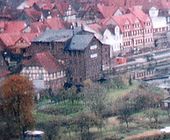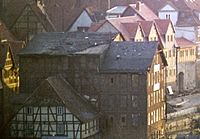Graumühle (Münden)
The Gray mill , sometimes as grave mill referred was one from the time of the Middle Ages derived watermill on the Fulda in southern Lower Saxony Hann. Münden . The mill, which was expanded in various construction periods in the 18th and 19th centuries, was demolished in the 20th century. In 1999, a run-of-river power plant was built on the foundation walls of the mill to generate electricity.
history


The Graumühle stood on the Kasseler Schlagd outside of the medieval city fortifications of Münden . They used the water of a Fulda arm, which is formed by the Eselwerder . This water channel was converted into a mill ditch during the Middle Ages . The first mention of the mill owned by the Guelph dukes dates back to 1398, when it was listed as a gray mole in the tax book of the Guelph Castle in Münden . According to the records, there were three mills in the village at that time: the Blümer Mühle , the Graumühle and the Werdermühle on the Tanzwerder . According to the mill justice at that time , the Graumühle was in sovereign possession. After the Guelphs, these were the legal successors of the Kingdom of Hanover and, from 1866, the Prussian state. In 1794 the gray mill was enlarged by a multi-storey half-timbered building. The mill had three undershot water wheels . They were replaced by two Francis turbines in 1875 . In the second half of the 19th century, the mill was expanded into an industrial mill with multi-storey brick buildings. In the 20th century, the state of Lower Saxony owned the mill and donated it to the city of Hannoversch Münden in 1957. In 1958 the company's grain and oil mills were shut down. After that, the mill served as a storage building. The city complied with the donation requirement to demolish the mill buildings as part of the renovation of the old town in 1976.
At the former location of the watermill, a run-of-river power plant with two Kaplan turbines was built in 1998 and 1999 , which has since contributed to the local power supply. The foundation walls of the previous mill building from the 17th century and the still existing turbine cellar were used. The system's turbines have a maximum output of 220 kW per hour and, according to the operator, cover the electricity needs of around 450 households.
Surname
The watermill has had various names throughout its history. The original name Grabenmühle was probably misunderstood as Graumühle. Later names came up after the tenants, such as Mündersche Mühle after the Münder millers who ran it in the 19th and 20th centuries. Later, Tauersche Mühle became a naturalization after the Mündener citizen Willi Tauer, who had it leased from 1959.
Earliest representation of the Graumühle (1585) opposite the Tanzwerder with the Werdermühle
Representation of the mill with a footbridge over the Eselwerder to Tanzwerder by Merian around 1654 (detail)
Location of the Graumühle on the Kasseler Schlagd and Eselwerder, 1728
The mill around 1900, on the left the Alte Packhof
literature
- Karl Brethauer : History of the grave mill in: Münden. Collected Essays. First episode. Publisher Hans Fiedler, Hann. Münden, 1984, pp. 69-70
Web links
- Development of the hydropower plant 1997-1999 ( Memento from April 4, 2005 in the Internet Archive )
- Description of today's hydropower plant at the former mill location
Coordinates: 51 ° 25 ′ 4.1 ″ N , 9 ° 38 ′ 57.8 ″ E







